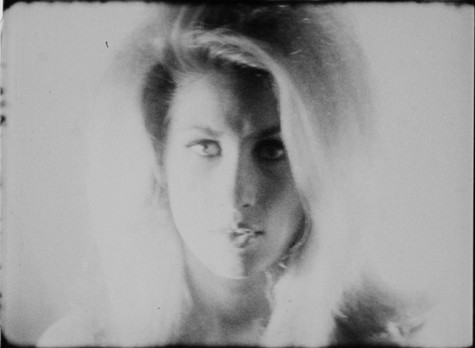The following assessments can be used for this lesson using the downloadable assessment rubric.
- Communication 3
- Communication 4
- Creative process 3
- Creative process 6
- Critical thinking 3
- Critical thinking 4

Andy Warhol, Screen Test: Jane Holzer [ST141], 1964
The Andy Warhol Museum, Pittsburgh; Founding Collection, Contribution The Andy Warhol Foundation for the Visual Arts, Inc.
© 2015 The Andy Warhol Museum, Pittsburgh, PA, a museum of Carnegie Institute. All rights reserved.
1997.4.113.141
Warhol’s Screen Tests are revealing portraits of hundreds of different individuals, filmed between 1963 and 1966. In these short films, Warhol created his own cache of Superstars. Superstars are actors interesting enough to carry a film on their own—not by playing a particular role but simply by being themselves. His subjects included both famous and anonymous visitors to the studio, including poet Allen Ginsberg, actor Dennis Hopper, and artist Salvador Dalí. When asked to pose, subjects were lit and Warhol filmed them with his stationary 16mm Bolex camera on silent, black-and-white, 100-foot rolls of film. Each Screen Test took exactly three minutes to create, lasting as long as the roll of film took to spool through the camera. The standard formula of subject and camera remaining almost motionless for the duration of the film results in a “living portrait.” When Warhol showed the films, he slowed them down slightly, extending their run time to about four minutes each, imparting a dreamy, slow-motion effect to the finished works.
While Warhol’s process was standardized, there are subtle lighting and focus variations in the Screen Tests. Jane Holzer’s is in soft focus and suffused with light, creating an ethereal, hypnotic effect, while Piero Heliczer’s is darker in mood. In addition, there are a number of Screen Tests that diverge from this format entirely, the sitter purposely moving, gesticulating, or using props.
These film portraits, referred to by the Hollywood term of “screen test,” were not created for the purpose of actually testing or auditioning actors. A traditional Hollywood screen test is a method used to judge whether an actor is suitable on film, and beyond that, if he or she is right for a specific character. Usually he or she is given a scene, a script, and instructions to perform in front of a camera. The director then watches the test to make a determination about the actor’s appearance and qualities on film.
Beauties in photographs are different from beauties in person. It must be hard to be a model, because you’d want to be like the photograph of you, and you can’t ever look that way. And so you start to copy the photograph. Photographs usually bring in another half-dimension. (Movies bring in another whole dimension. That screen magnetism is something secret—if you could only figure out what it is and how to make it, you’d have a really good product to sell. But you can’t even tell if someone has it until you actually see them up there on the screen. You have to give screen tests to find out.)
Andy Warhol, The Philosophy of Andy Warhol (From A to B and Back Again), 1975
The resulting films drastically reduced the roles of director and viewer alike. The director’s function was limited to choosing the subject, setting up the shot, turning the camera on and off and deciding whether or not to exhibit the result. And the viewer, for the first time in the history of the commercial exploitation of persistence-of-vision, was relieved of the obligation—perhaps even a large part of the desire—to pay attention to the screen. The standard ‘film-as-wallpaper’ definition of the early Warhol films doesn’t stand up, since their entire meaning and effect spring from the fact of their projection on a screen in a darkened room.
Writer Tony Rayns, Andy Warhol: Film Factory, 1989
The many Screen Tests evidence a variety of behavior of its portrait subjects, but amazingly little improvisation. The subjects actually look like they are captured and about to be interrogated, but the interrogation never happens, because Andy wanted to capture the essence of the person only, no interference, just like no interference with the camera as it recorded each “moving” still-life. The Screen Tests rank in the Warhol pantheon along with the Campbell’s Soup cans, Marilyns, and self-portraits.
Factory photographer and assistant Billy Name in Callie Angell,
Andy Warhol Screen Tests, 2006
As a group, watch the screen tests and discuss the on-screen personalities. Based on the footage, students determine which person would be best suited for various film roles: a villain, a best friend, a hero, a royal personage, etc. Students also critique the formal qualities of their screen tests.
Students create a written character sketch of three different personalities captured in the class screen test.
The following assessments can be used for this lesson using the downloadable assessment rubric.